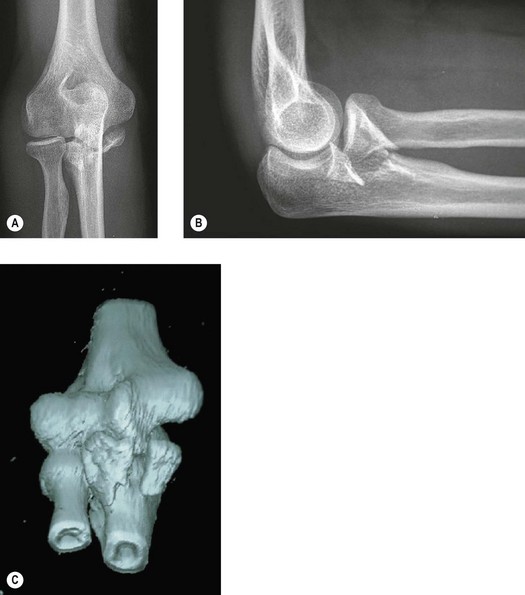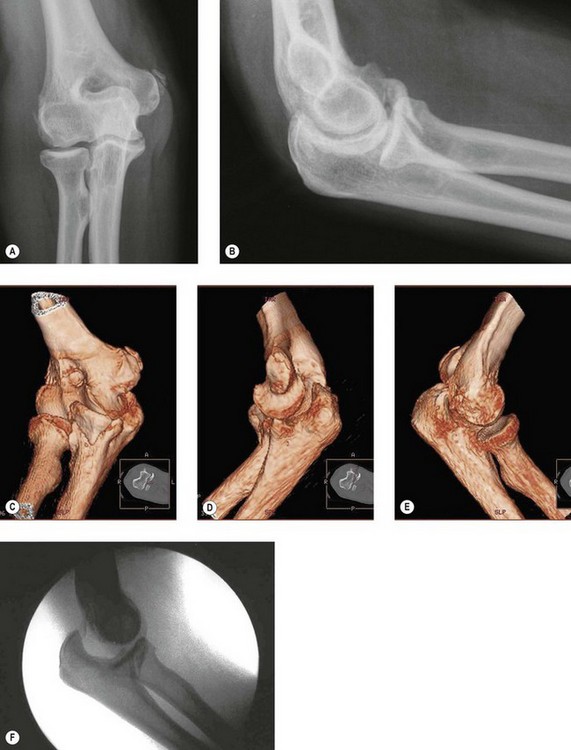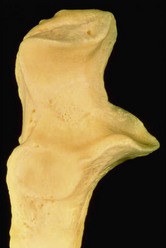Chapter 27 The Assessment and Management of Posteromedial Instability
Introduction
The most common mechanism of elbow dislocation occurs from a fall on the outstretched arm resulting in a combination of compressive, external rotatory and valgus forces. This causes the forearm (radius and ulna) to supinate away from the humerus ultimately leading to joint dislocation. This is termed posterolateral rotatory instability (PLRI).1,2 A much less common, and more recently described, mechanism of elbow trauma results from applied internal rotation and varus force. In this case, the proximal forearm pronates relative to the humerus, termed posteromedial rotatory instability of the elbow (PMRI).2–4 The injury results in joint subluxation, not dislocation, and typically leads to a unique fracture of the anteromedial coronoid due to impaction from the humeral trochlea. The clinical presentation can be much more subtle than PLRI, and the coronoid fracture often appears small and innocuous on plain radiographs. Thus, the diagnosis of PMRI requires a high index of suspicion. It must be emphasized, however, that this is a true fracture–subluxation of the elbow which may lead to joint deterioration if not identified and properly managed.
Presentation, investigation and treatment options
As noted, the mechanism of a posteromedial rotation injury to the elbow involves a fall in which the forearm pronates on the humerus. This is combined with axial compression and varus load (Fig. 27.1). Patients can present acutely after the trauma with a swollen and painful joint. When associated with larger coronoid fractures and greater force, radiographs can reveal obvious joint subluxation and incongruity. Three-dimensional computed tomography can allow a better appreciation of the bony injury as well as the rotatory mechanism (Fig. 27.2).
It is important to appreciate, however, that there is a spectrum of bony and soft tissue failure associated with these injuries. Patients can present acutely or in the subacute setting with a less significant history of injury, a less impressive examination (with limitation of only the end ranges of motion), and radiographs that appear quite innocuous only showing subtle evidence of a coronoid fracture (Fig. 27.3). This fracture is more vertically or obliquely oriented than the traditional transverse coronoid fracture.5 The extent of joint subluxation is hard to appreciate on frontal and lateral projections as the radiocapitellar relationship is preserved, i.e. there is no posterior translation of the radial head relative to the capitellum as seen in PLRI. In order to appreciate this injury pattern, the anteroposterior radiograph must be carefully evaluated for a double-density involving the coronoid along the medial joint line. This finding is characteristic of posteromedial rotatory injuries of the elbow. Again, three-dimensional computed tomography is very useful to identify the true extent of bony involvement and the joint subluxation (Fig. 27.3).
In addition to bony failure medially, the PMRI mechanism can also result in a soft tissue injury to the lateral ligamentous complex of the elbow. As the forearm pronates on the humerus and the medial ulnohumeral joint collapses and subluxates, the lateral joint is subjected to distraction forces. Thus, in almost all cases (an exception may be seen in the presence of an associated fracture of the coronoid at its base), there is an obligate failure of the lateral collateral ligament in tension (Fig. 27.3).2,3 This can be somewhat confusing, as this represents posterolateral joint instability (PLRI) in association with a posteromedial joint trauma (PMRI). However, recognition of lateral ligament disruption is important when addressing these injuries surgically.
Surgical techniques and rehabilitation
In order to surgically approach PMRI injuries, one must understand the anatomy of the coronoid. The proximal ulna has two main facets, the greater sigmoid notch, which articulates with the trochlea of the humerus, and the lesser sigmoid or radial notch, which forms the proximal radioulnar joint. The coronoid itself consists of an anterior projection and an anteromedial facet. The anteromedial facet is important for stability of the medial ulnohumeral joint. It also serves as an attachment for the anterior bundle of the medial collateral ligament, the primary stabilizer of the medial elbow (Fig. 27.4).6,7
Stay updated, free articles. Join our Telegram channel

Full access? Get Clinical Tree












